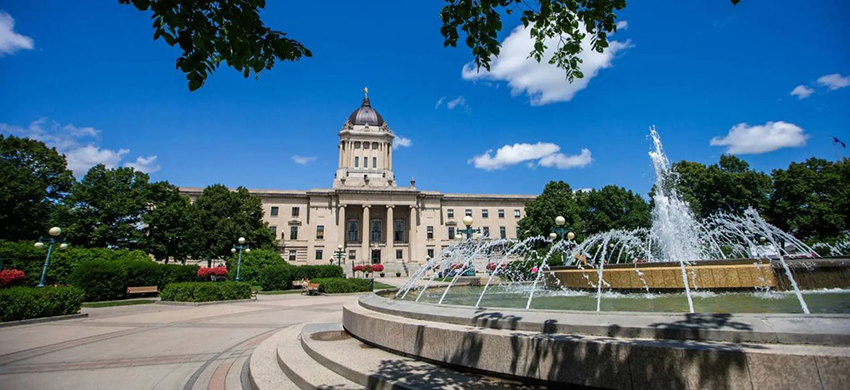By Brent Bellamy, Architect + Creative Director
Originally published in the Winnipeg Free Press
Nine city-building ideas that Manitoba’s new provincial government might consider to make Winnipeg a more livable and prosperous city.
Image: From tree planting to building houses, there are plenty of paths to an improved Manitoba for the city and provincial governments. Photo - Mikaela MacKenzi/Winnipeg Free Press
1. Build more housing.
Canada is in a housing crisis, and the provincial government can play a central role in its solutions. Increasing housing supply will require bringing together all stakeholders and co-ordinating strategies to leverage funding programs from other levels of government, including the federal Housing Accelerator Fund.
Increasing provincial funding to not-for-profit developers for construction and operation of affordable, student, and senior’s housing, and incentivizing private developers to increase market housing supply would begin to address housing need.
Realizing a campaign promise to eliminate PST on new rental construction, matching the federal government’s similar plan for the GST, would be an important step in counteracting the rise in interest rates and construction costs that are currently prohibiting new housing development.
2. Expand social housing supply.
The Manitoba government must use social housing as a foundational tool to address the issues of homelessness, core housing need, poverty and addictions that have led to increased crime and urban decay.
The solutions are complex and require an all-hands-on-deck approach from the provincial government, including the co-ordination of financial assistance programming and supportive resources with housing construction.
Key strategies include vastly expanding the supply of publicly owned, not-for-profit, and Indigenous-led social and supportive housing, restoring capital maintenance funding to renovate existing buildings, and retaining ownership of current public housing assets.
3. Restore Winnipeg Transit operations funding.
Public transit is vital to improving social equity and quality of life, providing affordable access to employment, education, and recreation. It’s also central to our climate change strategies.
The previous government cancelled the long-standing 50/50 transit funding agreement with the City.
Restoring this agreement, and further increasing operations funding, would provide stability to Winnipeg Transit and allow it to more quickly implement the new Primary Transit Network plan to increase frequency, reliability, and ridership.
4. Expedite Rapid Transit construction.
Rapid transit can advance quality of life and social opportunity, inspire investment and development, reduce carbon emissions, and improve civic competitiveness.
Winnipeg will soon be the only city of the country’s 10 largest without light rail transit, and while Winnipeg Transit’s master plan proposes a three-line bus rapid transit network, it does not anticipate completion until 2045.
The federal government is currently a partner in 18 rapid transit projects across Canada, representing an opportunity for the province and city to engage this willing investment partner to significantly reduce the protracted timeline and realize the benefits of rapid transit in this generation.
5. Sell provincially owned downtown surface parking lots.
In the 2016 provincial election, the NDP made a campaign pledge to sell nine government owned surface parking lots in downtown Winnipeg.
With many provincial employees now working from home, and downtown so heavily impacted by the post-pandemic world, this idea is even more relevant today.
These properties are some of the largest and most prominent parking lots in downtown and represent an opportunity to work with private developers to create affordable housing and mixed-use developments that bring new economic activity and vibrancy to the city’s core.
6. Tax downtown surface parking lots.
With a provincial amendment to the City of Winnipeg Charter, the city could be given the power to tax parking lots in downtown at a higher rate than elsewhere in the city.
This would make parking lots less profitable for property owners, encouraging them to look for more lucrative redevelopment opportunities. This strategy has been used to great effect in downtown Montreal.
7. Plant trees.
Cities are on the front lines in the battle against climate change and must begin focusing on building resiliency to the growing impacts. Planting trees is a vitally important strategy to achieve this.
Urban trees reduce air temperature during extreme heat events, and control the effects of wind, stormwater runoff and overland flooding.
Unfortunately, just when it’s needed most, Winnipeg’s iconic tree canopy is being increasingly decimated by two species of invasive insects, the Emerald ash borer, and the Elm bark beetle. This is resulting in a loss of about 12,000 mature trees every year.
Provincial funding could help implement the city’s Urban Forest Strategy, expediting the replanting of lost trees and improving maintenance schedules to help retain as many existing mature trees as possible.
8. Study rail relocation.
In 2016, the PC government cancelled a task force established to study Winnipeg rail relocation.
Mayor Scott Gillingham recently campaigned on the idea and would likely be a willing partner in a resurrected provincial initiative to finally establish a comprehensive understanding of the challenges and opportunities that relocating rail yards, or lines, represent.
It’s a long-term idea that could realize a generational transformation in how the city grows, or it could simply identify synergies and smaller moves that create new opportunities for infill development, greenspace, active transportation, and recreation.
9. Regulate river levels in the city.
A controversial big idea for the provincial government to consider is the possibility of using the floodway to permanently regulate river levels in the city.
Consistent river levels that make Winnipeg’s riverbanks accessible would breathe new life and economic growth into existing communities, unlocking the potential of the waterfront to attract development and recreational opportunities, increasing land values, and reducing pressure on riverbank stabilization and the combined storm-sewer system.
Past studies have concluded that the idea provides many important benefits but is difficult to achieve politically because of downstream impacts. Careful study and collaborative consultation could find solutions that benefit all, resulting in a city that truly embraces its rivers with active urban waterfronts.
Brent Bellamy is creative director at Number TEN Architectural Group.


